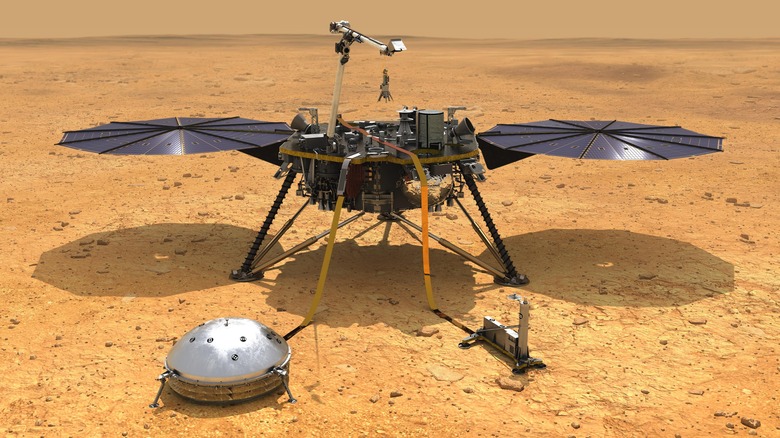How Scientists Measure The Quakes Which Shake Mars
As well as the earthquakes that happen here on Earth, similar events happen on Mars, which is regularly shaken by marsquakes. NASA's InSight lander has an instrument called a seismometer for detecting marsquakes, and in May 2022, it picked up signs of the largest quake ever detected on another planet: a magnitude 5 quake detected on the 1,222nd Martian day of its mission (via JPL). InSight has detected more than 1,300 marsquakes since the beginning of its mission in 2018. It uses its seismometer to pick up the seismic waves which pass through the planet.
By sensing these waves and pinpointing the location where they originated, scientists can figure out information about Mars' interior, such as the size and density of its mantle and core. Before May 2022, the biggest marsquake previously detected was a magnitude 4.2 in August 2021. In light of that, the researchers were excited to record the magnitude 5 quake as it could give some of the best information yet about the interior of Mars, according to the lead investigator for InSight, Bruce Banerdt of NASA's Jet Propulsion Laboratory: "Since we set our seismometer down in December 2018, we've been waiting for 'the big one.'"
This quake is sure to provide a view into the planet like no other. Scientists will be analyzing this data to learn new things about Mars for years to come." The seismometer instrument called the Seismic Experiment for Interior Structure (SEIS) sits under a dome which InSight placed on the Martian surface (via NASA). It takes measurements of the vibrations coming from seismic activity on the planet, while other instruments on the lander measure weather factors like wind, pressure, and temperature.
Looking beneath the surface of Mars
Data from InSight has been used to understand the interior structure of Mars. Research published in 2021 gave information about the size of the different layers of Mars' interior — its crust, mantle, and core — as well as the composition of each layer. Unlike Earth, where the outer core is molten metal around a solid metal core, researchers think that Mars has a molten core (via NASA).
On Earth, earthquakes are caused by the movements of tectonic plates. But Mars does not have tectonic plates, as its crust is one solid piece. Researchers think that marsquakes are caused by fractures forming in this crust as the planet cools and shrinks. When a marsquake occurs, the vibrations spread through the interior of the planet. By measuring at the point with InSight, researchers can see either primary vibrations (called P waves) or secondary vibrations (called S waves).
"What we're looking for is an echo," said the lead author of one of the research papers, Amir Khan of ETH Zurich. "We're detecting a direct sound — the quake — and then listening for an echo off a reflector deep underground." There are also recent theories that marsquakes might come from another source, though. Rather than being due to cracks in the crust, some researchers have suggested that they could result from volcanic activity that happens beneath the martian surface (via phys.org).
